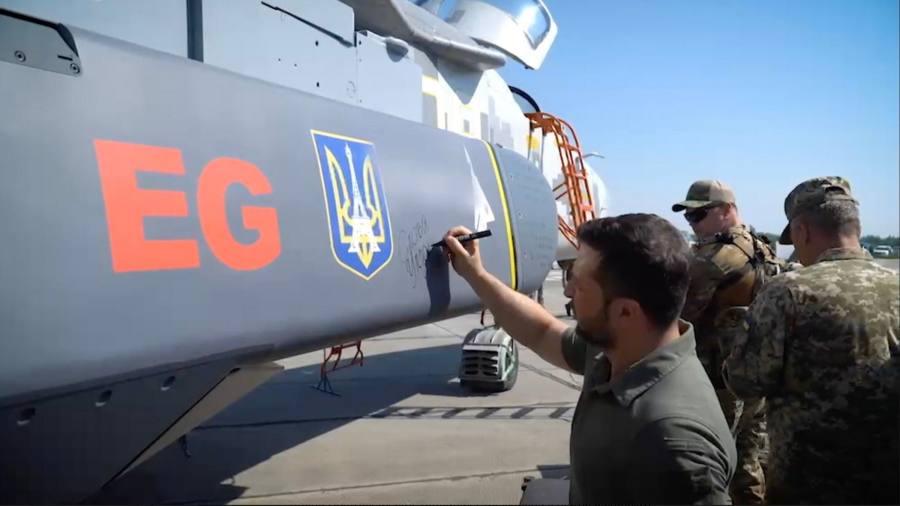Receive free Ukraine military briefing updates
We’ll send you a myFT Daily Digest email rounding up the latest Ukraine military briefing news every morning.
Russia’s increased attacks on targets deep within Ukraine appear to have one goal above all: destroying Kyiv’s ability to launch the long-range missiles it is receiving from western allies.
Moscow launched dozens of missiles this week far into western Ukraine, targeting air bases, air strips and a pilot training facility that are up to 1,000km from the front line. Ukrainian officials said 28 cruise missiles were fired on Tuesday alone, 16 of which were intercepted.
The strikes are seen by Kyiv and its allies as part of a weeks-long effort to shatter Ukraine’s runways and the fleet of bombers used to fire British Storm Shadow and French Scalp missiles, according to people familiar with the matter.
To avoid being hit, Ukraine is now racing to move around crucial weaponry and its skilled personnel, officials said. Ukrainian pilots are constantly shuttling around dozens of domestic air bases and commercial airports.
“It’s no surprise that they are trying to destroy our aviation and pilots,” said Colonel Yuriy Ignat, spokesperson for Ukraine’s air force. “Our pilots are bothering them . . . [and] causing a lot of trouble.”
The long reach of these western missiles has played a significant role in helping Ukraine make some modest advances against Russian positions. Ukraine on Wednesday said its forces had liberated the village of Urozhayne in southern Donetsk region.
“The French Scalps and British Storm Shadows provided to us have actually played a decisive role,” said Valeriy Kondratiuk, former head of Ukraine’s military and foreign intelligence agencies. Russia had no other way to stop those strikes than “to hit the airfields where the planes from which these missiles are launched are located”.
The UK was the first to supply its Storm Shadow missiles, followed by France’s Scalps — and officials say both are making a difference in combat. The US and Germany remain more wary of sending long-range missiles to Ukraine, fearing the missiles risk escalating the conflict, particularly as they can be used to strike targets within Russia.
Ukraine says its pilots only fire western missiles within its borders to strike Russian arsenals, command posts and logistics points in occupied territories, including bridges.
In the first months of the war, Ukraine had to rely on a swiftly depleting Soviet arsenal of surface-to-air missiles, including S300s and Buks, which prevented Russia from establishing air superiority. This has forced the Russian military to fire its missiles from Russia and the Crimean peninsula.
Occupied by Russia in 2014, Crimea has been heavily militarised and used as a staging ground for the full-scale invasion unleashed last year.
Nato-grade air defence systems supplied by western allies, including US-made Patriots, Norwegian-American NASAMS and Germany’s Iris-Ts helped protect Ukraine’s skies. But Ignat said more systems are needed to better shield air bases as well as other military and civilian infrastructure that Russia targets almost daily.
Yuriy Sak, an adviser to Ukraine’s defence minister, confirmed that Russia has recently increased its attacks on air bases and repeated calls for “more air defence systems”.
Kyiv argues that US-made ATACMS and German Taurus missiles would further soften the ground for its infantry that has struggled a third month into its counteroffensive to break through multiple layers of Russian fortifications along the front line in the country’s south-east.
General Ben Hodges, former commander of the US army in Europe, echoed Ukraine’s call.
“Right now we should be loading up ATACMS, Taurus missiles, more Storm Shadows and other long-range systems on to C17 transport aircraft and flying them to Ukraine as fast as possible,” he said.
Hodges said Russia was “desperate” to make sure Ukraine does not acquire the capability to start hitting bases in Crimea, which could potentially drive them out of the peninsula.
Russia’s air strikes targeting Ukrainian air bases were an attempt to prevent such a turning point in the war, he said.
“The Russians know that they are extremely vulnerable. And the worst thing that can happen to them is for Ukraine to get the ability to start hitting with regularity and precision the Black Sea fleet base at Sevastopol, air bases and logistics hubs,” he added.
In Berlin, where the debate around supplying Taurus missiles is reminiscent of the tortuous wrangling preceding the decision to send Leopard tanks, finance minister Christian Lindner recently threw his weight behind Kyiv’s call.
So did Norbert Röttgen, a prominent member of the German Bundestag with the opposition Christian Democrats (CDU): “We have to do more . . . both regarding the protection of the launch sites for cruise missiles and also regarding [the Black Sea port city] Odesa, which is not sufficiently protected.”
Sak urged Ukraine’s western allies to speed up agreed training of Ukrainian pilots and the supply of F16 fighter jets to better protect the country’s skies.
He said the air base strikes “demonstrate that Russians are terrified by the prospect of Ukraine getting F16s, because they know that it will considerably help Ukraine win faster”.
Additional reporting by Laura Pitel in Berlin
Read the full article here



